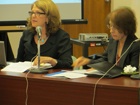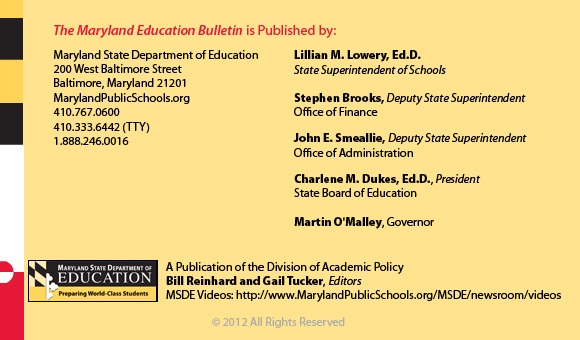
|
||
December 21, 2012
|
| MSDE Home | Newsroom | MDReportcard.org | School Improvement | | |
The events of last week at Sandy Hook Elementary in New Town, CT, shocked and saddened every one of us. Every day we learn more about the remarkable children and educators lost in that senseless tragedy, and every day our hearts break a little more. * * * Improved safety and student discipline practices was the theme of a great event last week in Howard County. MSDE joined with the Open Society Institute-Baltimore and the Advancement Project to hold “Courageous Conversations about Discipline: Creating a Positive School Climate for All.” The conference was standing room only, a testament to the importance of the topic. Our State Board has a goal: making certain our students receive all the educational services they deserve so they have every opportunity to graduate college- and career-ready. Reducing the number of student suspensions – while maintaining safe schools – is the way to make that happen. We now know that bullying is not just a rite of passage—it has long term and serious results. Bullying can lead to low self-esteem, depression, isolation, and alienation in both the bully and the victim long after the incidents have ended. In addition, many victims of bullying do not want to come to school, leading to disengagement from the classroom and all that is offered by public education.
* * * Let’s give a round of applause to John Eager Howard Elementary in Baltimore City, named as a National Title I Distinguished School for the 2012-2013 school year. The school will be honored in Nashville next month. * * * Have a warm and joyous holiday season. Thank you for everything you do each day to help Maryland students succeed – no matter what your role! * * * Connect with MSDE on Facebook!
Calendar 2012 Milken Winner in Harford County December 12, 2012 2012 Harford County Reading Specialist Lauren Hunter, of William Paca Elementary School in Abingdon, wins a $25,000 Milken Educator Award. The award is a surprise announcement made at a school assembly. New Accountability System Measures Progress Having trouble viewing this email? Click here for a PDF version of the MSDE December 21, 2012 Education Bulletin. If you would prefer not to receive future Newsletters from us, simply click here, and insert in the subject line, Unsubscribe.
|
NEW ACCOUNTABILITY SYSTEM TARGETS IMPROVEMENT The Maryland State Department of Education this week unveiled the School Progress Index (SPI), a new accountability system designed to spur improvement in every school.
The School Progress Index assesses each one of Maryland’s 1,400 schools on their individual school goals, rather than by an absolute measure. It takes into account a school’s progress determined by its overall student performance, student growth, closing of gaps between the highest and lowest student subgroups, and preparation for college and careers. The new school accountability system, released in a meeting of the State Board of Education, was made possible by the flexibility Maryland officials received this year from some of the U.S. Department of Education’s No Child Left Behind (NCLB) mandates, initially set a decade ago. NCLB required that all schools be gauged on absolute targets known as Adequate Yearly Progress, labeling schools that failed to meet those targets as “in need of improvement.” State Superintendent of Schools Lillian M. Lowery said the SPI is a better yardstick for school improvement. “We should be rewarding those underperforming schools that have started to make real progress, just as we should be taking a closer look at top schools whose progress may have stalled in some areas,” Dr. Lowery said. “Each school now has its own targets at which to aim, and that paves the way for continued progress in all of our classrooms.” The Elementary and Secondary Education Act (ESEA), known in its most recent iteration as No Child Left Behind, has had as its goal that every student reach proficiency levels in reading and mathematics by the 2013-14 school year. While Maryland schools have made steady progress since the law was enacted in 2002, the rigid parameters of the law were recognized by President Obama, Education Secretary Duncan, and other policymakers. Secretary Duncan announced the ESEA flexibility plan last June, and Maryland applied in the program’s second round. Maryland is one of 34 states that have now been approved for flexibility, with seven more plans currently under review. Under its plan, Maryland will cut in half the percentage of its non-proficient students by 2017. The School Progress Index is central to Maryland’s flexibility plan. Each school’s SPI offers a snapshot of its improvement, providing educators and parents with data points critical to gauging a school’s success at meeting its goals. The SPI is calculated differently for the K-8 and high school levels. The SPI for kindergarten through eighth grade schools is calculated through three indicators: Achievement (Maryland School Assessment scores in mathematics, reading, and science), Growth (student improvement on math and reading MSAs), and Gap Reduction (cutting the achievement gap between the low and high performing student subgroups at the school level in state assessments). High School SPI is calculated through three indicators: Achievement (High School Assessment scores in algebra/data analysis, English, and biology); Gap Reduction (cutting the achievement gap between the low and high performing subgroups at the school level on the state assessments, as well as cohort graduation and dropout rates), and College- and Career-Readiness (cohort graduation rate and college and career preparation). The latter is a measure of a students’ success in one of the following areas: Advanced Placement (AP) or International Baccalaureate courses (IB); Career and Technology Education (CTE) Concentrators; or Enrollment in College (two-year, four-year, or technical education program. Calculation of the School Progress Index was made possible by improvement in the state student data system that allowed MSDE to follow progress for each student year to year. High school graduation and dropout rates now more precisely follow each cohort of students through high school on into college or career. Maryland schools will benefit from the continued improvement in data as we move forward. Each school receives a score on each of the indicators and the overall School Progress Index. This information places schools into Strands – categories that organize schools for recognition, support, and possible intervention. These Strands will allow systems to better target resources, helping to ensure continuing progress for all students, no matter how the school performs on an overall basis. The School Progress Index is being instituted at a time of great change for the State’s education system. Maryland schools are in the process of instituting the Common Core State Standards, a more rigorous curriculum in reading and mathematics. The standards will be fully implemented by the 2013-14 school year, with new assessments built on that curriculum ready for use in the 2014-15 school year. “We must resist the temptation of being satisfied with the status quo, even at our best schools,” Dr. Lowery said. “Our job is to peel back the layers, celebrate where we are succeeding, and take action where the news isn’t quite so good. Maryland students and parents deserve no less.” School Progress Index information for each of Maryland’s 1,400 public schools is available at http://MdReportCard.org. Additional SPI information is available at http://MarylandPublicSchools.org.
Six Maryland public schools this week were selected as 2013 Maryland Blue Ribbon Schools. The schools are:
The schools are recognized on the basis of rigorous state and national requirements for high achievement and dramatic improvement. The students in each of these schools perform at the top 15 percent on State assessments in reading and mathematics. “While Maryland has scores of outstanding schools and classrooms, the Blue Ribbon School Award is a true honor for each one of these recipients,” said State Superintendent of Schools Lillian M. Lowery. “We congratulate the students, teachers, administrators, and communities, and look forward to great results in the national competition.”
|
||||||
|
|
|||||||



